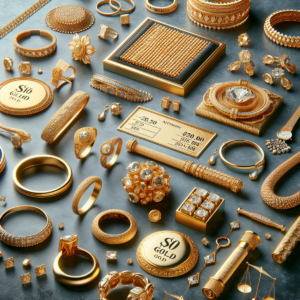Gold jewellery has always been popular, regardless of time or culture. Two of the most widely recognized types of gold jewellery are 21k and 22k jewellery. These pieces are special because they contain a large amount of gold and have a rich color.
This guide will give you the knowledge you need about gold purity and explain the unique features of 21k and 22k gold jewellery. It will show you how these two types of jewellery are different in terms of their composition, color, durability, and other qualities.
Whether you’re thinking about buying a beautiful 21k bracelet or an intricate 22k necklace, this guide will provide valuable information to help you make smart choices when buying these special pieces. The goal is to ensure that every item you select not only increases the value of your collection but also reflects your personal style and preferences.
Now, let’s explore the world of gold purity starting with an explanation of the Karat system and fineness measurement!
Understanding Gold Purity
When it comes to gold jewellery, purity matters. It’s a key factor that not only determines the value of your piece but also its color, durability, and appeal. But how exactly do we gauge gold purity? This is where the Karat System and Fineness Measurement come into play.
The Karat System vs. Fineness Measurement
The Karat System is a widely recognized method of expressing gold purity. In this system, pure gold is measured as 24 karats (24k). A piece of gold jewellery’s karatage tells you the number of parts of pure gold to other metals. For instance, in a 22k piece, 22 parts are pure gold while the remaining 2 parts are other metals such as copper or silver.
In terms of 21k and 22k gold, these karats translate to:
- 21k Gold: Comprising 87.5% gold, this means that out of a possible 24 parts, 21 parts are pure gold and the remaining three parts are made up of other alloyed metals.
- 22k Gold: With a composition of 91.6% gold, here, 22 out of 24 parts are pure gold while just two parts consist of other metals.
While the Karat system is commonly used in many countries including the United States and Canada, an alternative method known as Fineness Measurement is adopted by many international markets like Europe.
Contrary to the karat system which operates on a scale of 24, fineness expresses purity in parts per thousand. For example, 21K (87.5% pure) and 22K (91.6% pure) would be represented as 875 and 916 fineness respectively.
Minimum Gold Purity Standards in Jewellery Making
A cornerstone for maintaining quality standards within the jewellery industry is the establishment of minimum gold purity requirements. These are set by regulatory bodies and vary across countries.
For instance, in the United States, the minimum standard is 10k for an item to be legally sold as gold jewellery. In contrast, countries like the UK, France, and Portugal have set their benchmark at 9k whereas Greece and Denmark deem 8k as acceptable.
By setting these standards, both consumers and manufacturers can benefit. Consumers are assured of a certain level of quality while manufacturers have guidelines to maintain consistency.
Comparing the Characteristics of 21K and 22K Gold Jewellery
While both 21k and 22k gold are high-purity metals with their own unique characteristics, they differ slightly in terms of their color profiles, design versatility, and maintenance needs.
Color Profiles
Given their high gold content, both 21k and 22k pieces exhibit a rich yellow hue that is deeply cherished by gold enthusiasts. However, it’s worth noting that the higher the karatage (and thus, the gold content), the deeper and more intense is this yellow coloration. As such, a 22k piece would display a slightly richer hue compared to a 21k one.
Design Versatility
The higher percentage of pure gold present in these karats makes them softer than lower-karat alternatives. This malleability allows jewellers to craft intricate designs with ease. However, this also means that high-karat
Understanding Gold Purity in Jewellery Making
When buying jewellery, it’s important to understand what gold purity means. It’s not just about how shiny it looks; the purity of gold tells us its value and how long it will last. There are different ways to measure the quality of gold, such as the karat system and fineness measurement. These methods exist for a reason—they follow strict rules set by authorities worldwide to make sure that jewellery meets certain quality standards.
Gold purity is more than just a number; it reflects the true nature of the jewellery piece you choose to wear. Let’s take a closer look at the minimum carat requirements and how these rules benefit both consumers and the jewellery industry:
1. Regulatory Standards
International organizations have set minimum gold purity standards to ensure that anything labelled as “gold jewellery” meets these requirements. For example, in the United States, any item sold as gold must be at least 10 karats, which means it contains 41.7% pure gold.
2. Minimum Carat Requirements
These standards differ from country to country. In European nations like the UK, France, and Portugal, the minimum requirement is 9 karats (37.5% pure gold), while Greece and Denmark have an even lower threshold at 8 karats (33.3% pure gold). These minimum requirements make sure that consumers are buying real precious metals.
3. Consistency and Quality Control
By following these minimum standards, jewellers maintain consistency in their products. This helps build trust with consumers who rely on these benchmarks to judge the value and authenticity of their purchases.
4. Consumer Confidence
When you’re shopping for a gold necklace or any other piece of fine jewellery, knowing these standards can help you make choices that reflect both your style preferences and investment plans.
Key Takeaway: The karat system and fineness measurement are not just indicators but guarantees of a piece’s quality—critical knowledge for any discerning buyer looking to invest in lasting luxury.
By understanding these basics, consumers can navigate the jewellery market more effectively and jewellers can maintain a tradition of excellence that has been valued for centuries. Quality standards in jewellery making aren’t just about following rules—they protect heritage, making sure that each piece continues the legacy of fine craftsmanship and purity.
Comparing the Characteristics of 21K and 22K Gold Jewellery
When comparing 21k and 22k gold jewellery, it’s important to understand the key differences between these two purity levels. These differences go beyond just looks and also affect factors like design options and maintenance requirements.
Colour Profiles:
- 21k Jewellery: With 87.5% gold content, this type of jewellery has a warm yellow color that is slightly less bright than 22k but still very rich.
- 22k Jewellery: With a higher gold content of 91.6%, this type of jewellery has a deeper, more intense yellow shade that is often associated with luxury.
Design Versatility:
- 21k Jewellery: This type of jewellery is slightly harder due to the higher amount of other metals mixed in, which makes it more suitable for intricate designs without sacrificing too much durability.
- 22k Jewellery: Because it has a higher gold content and is therefore softer, this type of jewellery may not be able to handle complex designs as well and is better suited for bold, simpler pieces.
Long-term Maintenance Needs:
- 21k Jewellery: This type of jewellery is known for its durability; while regular care is still necessary with frequent wear, there is less risk of it getting easily damaged or deformed.
- 22k Jewellery: Due to its softer nature, extra care is required when wearing and storing this type of jewellery to prevent bending or scratching.
As you consider the unique characteristics of each type, remember that your personal preference should be a guiding factor. The cultural significance of certain types may also influence your decision-making process, as well as how often you plan on wearing these special pieces. Whether you’re drawn to the slightly sturdier nature of 21k gold or the luxurious appeal of 22k gold, make sure your choice reflects both your aesthetic preferences and practical needs.
Is 18K or 22K Gold a Better Option for You?
Navigating the world of gold jewellery can be complex, especially when you have to choose between different gold purities. Two common options that you might come across are 18k and 22k gold.
Understanding 18K Gold
Let’s start with 18k gold. It is made up of 75% pure gold mixed with 25% other metals like copper or silver. This combination gives it a slightly less bright color compared to higher purity options. However, what it may lack in brightness, it makes up for in strength.
Here are some key features of 18k gold:
- Purity Level: With a gold content of 75%, this means that out of 24 parts, 18 parts are pure gold and the remaining 6 parts are other metals.
- Colour Range: Due to its composition, 18k gold has a more understated tone compared to purer gold types. Its colour can vary from pale yellow to rose and white, depending on the specific alloys used.
- Durability: The mixture of other metals not only makes 18k gold stronger but also highly resistant to everyday wear and tear. This makes it an excellent choice for items like wedding bands or engagement rings that will be worn regularly.
Exploring 22K Gold
On the other hand, we have 22k gold. This type of gold is almost pure, consisting of 91.6% pure gold and only a small percentage (8.4%) of other metals.
Here are some key features of 22k gold:
- Purity Level: As the numbers suggest, out of every 24 parts, an impressive 22 parts are pure gold while only two parts consist of other metals.
- Color Range: Due to its high purity level, 22k gold usually has a deep yellow color which can be quite attractive for those who prefer a warmer gold shade.
- Durability: While it may not be as strong as 18k gold, its malleability allows craftsmen to create intricate designs, making it ideal for special occasion pieces.
Making the Right Choice
The decision between 18k and 22k gold is highly personal and should be based on your lifestyle, budget, and aesthetic preferences. Here are some factors to consider:
- If you lead an active lifestyle or plan to wear the jewellery daily, 18k gold’s durability may be more suitable for you.
- If you’re looking for a specific colour tone in your gold jewellery, understanding the colour range of each purity level can help you make an informed decision.
- If you appreciate delicate and detailed designs in your jewellery, the malleability of 22k gold might be appealing to you.
- Budget is also an important factor to consider. Generally, 18k gold tends to be more affordable than 22k gold due to its lower gold content.
Now that you have a better understanding of the differences between 18k and 22k gold, you can confidently choose the right option based on your preferences and needs.
Making the Right Choice: Factors to Consider When Buying Gold Jewellery
Purchasing gold jewellery is a significant investment, hence a decision not to be taken lightly. It’s crucial that you take into consideration several factors before making your choice between 21k and 22k gold.
1. Authenticity
Always buy from trusted sources. Ensure that the vendor provides proper authentication of gold purity. This can come in the form of hallmarks or certifications. Hallmarks are small impressions stamped into the gold which affirm its karatage. For example, 21k gold might be marked as ‘875’ indicating its 87.5% purity, while 22k could be marked ‘916’ signifying 91.6% purity.
2. Style and Lifestyle
Gold jewellery is an extension of your personal style. Choose pieces that reflect your aesthetic preferences. If you prefer a deep yellow hue, 22k gold would be a better fit for you as it has a higher purity level. However, if you plan on wearing your jewellery frequently, consider opting for 21k due to its enhanced durability.
3. Quality Standards
Irrespective of whether you choose 21k or 22k gold, it’s important to ensure that your chosen pieces meet quality standards. This refers not only to the purity of gold but also to the craftsmanship involved in creating the piece.
A careful evaluation of these factors will assist you in making an informed decision, ensuring that your gold jewellery purchase aligns with both your style preferences and lifestyle needs while also meeting quality standards.
Caring for Your Precious Gold Pieces
Proper maintenance is essential to preserve the luster and value of your gold jewellery, whether it’s 21k or 22k. Here are some gold jewellery care tips to ensure your pieces remain as captivating as the day you bought them:
Safe Storage
- Separate Compartments: Store each piece in individual soft cloth pouches or lined jewellery boxes to prevent scratches.
- Controlled Environment: Keep your gold away from direct sunlight and in a place with moderate temperature and low humidity to avoid tarnishing.
Regular Cleaning
- Gentle Solution: Use a solution of warm water and mild dish soap to soak your gold jewellery for a few minutes.
- Soft Brushing: After soaking, use a soft-bristled brush (like a baby toothbrush) to remove any dirt gently.
- Rinse and Dry: Rinse the pieces in warm running water and pat dry with a soft, lint-free cloth.
Professional Check-ups: Take your gold jewellery for professional cleaning and inspection annually to check for any necessary repairs.
By following these storage and cleaning tips, you’ll ensure that your gold jewellery stays beautiful for years to come.
Embracing the Timeless Appeal of 21K and 22K Gold Jewellery
As we come to the end of this guide, you now have a good understanding of gold purity and how it affects jewellery. You’ve learned about the unique characteristics of both 21k and 22k gold jewellery. But when it comes down to making a decision, it’s important to remember that personal preference plays a significant role, along with your own style and lifestyle.
The Allure of 21K Gold Jewellery
- 21k jewellery contains slightly less gold compared to 22k, which makes it more durable and suitable for everyday wear.
- Its warm golden colour and ability to withstand daily use without much damage make it a practical choice for regular accessories.
The Elegance of 22K Gold Jewellery
- 22k jewellery has a higher gold content, resulting in a deeper, richer golden hue that sets it apart.
- While it may be softer due to its higher purity, the exquisite beauty it brings to special occasions is undeniable.
No matter the karatage, every piece of jewellery has its own special quality that can’t be measured solely by its gold purity. Often, the sentimental value attached to a piece – whether it’s an heirloom passed down through generations or a gift commemorating a significant milestone – goes beyond just the technical aspects of gold purity.
So whether you prefer the durability of 21k or the luxury of 22k, embrace your choice knowing it reflects who you are. Your decision will add another layer of meaning to your chosen piece, making it even more precious than its gold content alone.
Frequently ask questions
1. What is the main difference between 21K and 22K gold?
The main difference lies in their purity levels. While both are high-purity gold, 21K contains 87.5% gold, whereas 22K contains 91.6% gold.
2. Which is better for everyday wear, 21K or 22K gold?
21K gold, being slightly less pure, is often preferred for everyday wear due to its increased durability compared to 22K gold.
3. Does higher gold purity affect the color of the jewellery?
Yes, higher gold purity typically results in a deeper and more intense yellow color. Therefore, 22K gold tends to have a richer hue compared to 21K gold.
4. Are there any specific care instructions for 21K and 22K gold jewellery?
While both types require regular cleaning and care, 22K gold, being softer, may need extra attention to prevent bending or scratching.
5. Can I mix and match 21K and 22K gold jewellery?
Absolutely! Mixing different karatages can add depth and interest to your jewellery collection. Just be mindful of the differences in color and durability.
6. How can I ensure the authenticity of 21K and 22K gold jewellery?
Look for hallmarks or certifications indicating the gold’s purity. Additionally, buy from reputable sources to ensure authenticity and quality.
Conclusion:
In conclusion, whether you opt for the enduring durability of 21K gold or the luxurious allure of 22K gold, your choice reflects not only your style but also your appreciation for timeless craftsmanship. Understanding the nuances of gold purity empowers you to make informed decisions, ensuring that each piece you select becomes a treasured symbol of elegance and refinement for years to come. Embrace the beauty and significance of gold jewellery, knowing that its value transcends mere karats—it embodies your unique story and personal expression.
For further inquiries or assistance, please feel free to contact anvarluxury. We’re here to help you find the perfect piece that resonates with your style and preferences.







